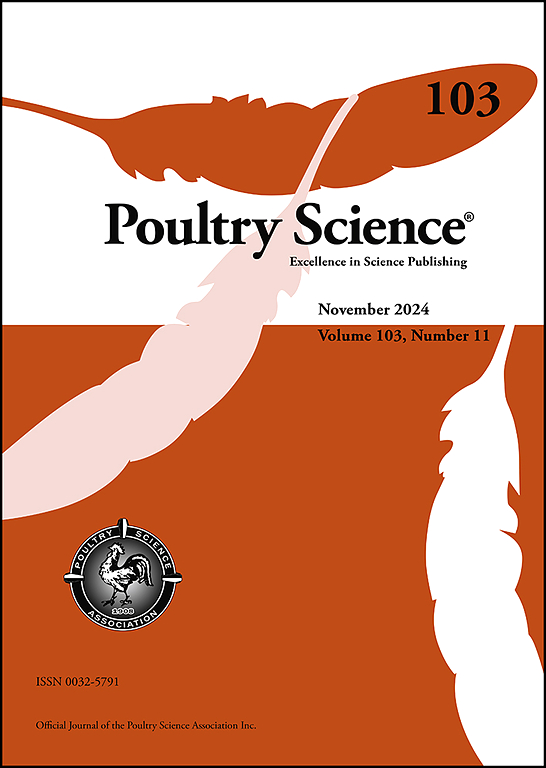肉鸡对丁香和牛至精油的分子反应与减少炎症和改善肠道屏障功能有关。
IF 3.8
1区 农林科学
Q1 AGRICULTURE, DAIRY & ANIMAL SCIENCE
引用次数: 0
摘要
采用体外实验研究了鸡对丁香精油(CEO)和牛至精油(OEO)的宿主介导反应。实验采用鸡巨噬细胞(CMCs)、鸡肠上皮细胞(IECs)、鹌鹑肌细胞(QMCs)和鸡胚胎肌细胞(EMCs)。取13日龄胚卵孵育时的EMCs,所有细胞系以2 × 105/mL接种于24孔板。在CMCs中,用1.0µg/mL的脂多糖(LPS)刺激诱导炎症反应。为了诱导肌肉细胞分化,qmc中使用0.5% FBS, EMCs中使用2.0% FBS。给予三种不同浓度(1.0、10.0和100µg/mL)的CEO和OEO。采用qRT-PCR检测CMCs中IL-1β和IL-8, IECs中occludin、ZO-1和MUC2, QMCs和EMCs中Pax7和MyoG的基因表达水平。采用MTT法测定CEO和OEO的细胞毒作用;在浓度低于0.1 mg/mL的cmc、IECs、QMCs和EMCs中,CEO和OEO没有表现出细胞毒性。CEO降低了lps诱导的CMCs中IL-1β和IL-8的升高(P < 0.05),增加了IECs中ZO-1和MUC2的升高(P < 0.05)。OEO抑制了IL-8的释放(P < 0.05),增加了ZO-1和Pax7的释放。CEO和OEO均表现出对柔嫩芽胞杆菌和产气荚膜荚膜梭菌孢子虫的杀微生物活性,但剂量仅比饲料中使用的剂量高10-100倍。这些发现支持了我们之前对其他植物化学物质的发现;CEO和OEO都是提高鸡韧性的有希望的候选者,不是由于它们的直接抗菌作用,而是由于宿主水平上发生的肠道生理反应。本文章由计算机程序翻译,如有差异,请以英文原文为准。
Molecular responses to clove and oregano essential oils are associated with reduced inflammation and improved gut barrier function in broiler chickens
In vitro tests were conducted to characterize the host-mediated responses of chickens to Clove Essential Oil (CEO) and Oregano Essential Oil (OEO). Chicken macrophage cells (CMCs), chicken intestinal epithelial cells (IECs), quail muscle cells (QMCs), and chicken embryonic muscle cells (EMCs) were utilized in these assays. EMCs were collected from the 13-day-old embryo during egg incubation and all cell lines were seeded at 2 × 105/mL in a 24-well plate. In CMCs, an inflammatory response was induced by stimulating with 1.0 µg/mL of Lipopolysaccharide (LPS). To induce muscle cell differentiation, 0.5 % FBS was used in QMCs and 2.0 % FBS in EMCs. Three different concentrations (1.0, 10.0, and 100 µg/mL) of CEO and OEO were administered. qRT-PCR was used to measure gene expression levels of IL-1β and IL-8 from CMCs, occludin, ZO-1, and MUC2 from IECs, and Pax7 and MyoG from QMCs and EMCs. Cytotoxic effects of CEO and OEO were determined using an MTT assay; CEO and OEO did not show cytotoxicity at concentrations below 0.1 mg/mL in CMCs, IECs, QMCs, and EMCs. CEO reduced (P < 0.05) the LPS-induced increase of IL-1β and IL-8 in CMCs and increased (P < 0.05) ZO-1 and MUC2 in IECs. OEO suppressed (P < 0.05) the release of IL-8, increased ZO-1, and Pax7. Both CEO and OEO demonstrated microbicidal activity against sporozoite of E. tenella and C. perfringens bacteria, but only at doses 10-100 × higher than those that would be used in feed. These findings support our previous findings on other phytochemicals; both CEO and OEO are promising candidates for improved resilience in chickens not due to their direct antimicrobial effects, but due to gut physiological responses that take place at the level of the host.
求助全文
通过发布文献求助,成功后即可免费获取论文全文。
去求助
来源期刊

Poultry Science
农林科学-奶制品与动物科学
CiteScore
7.60
自引率
15.90%
发文量
0
审稿时长
94 days
期刊介绍:
First self-published in 1921, Poultry Science is an internationally renowned monthly journal, known as the authoritative source for a broad range of poultry information and high-caliber research. The journal plays a pivotal role in the dissemination of preeminent poultry-related knowledge across all disciplines. As of January 2020, Poultry Science will become an Open Access journal with no subscription charges, meaning authors who publish here can make their research immediately, permanently, and freely accessible worldwide while retaining copyright to their work. Papers submitted for publication after October 1, 2019 will be published as Open Access papers.
An international journal, Poultry Science publishes original papers, research notes, symposium papers, and reviews of basic science as applied to poultry. This authoritative source of poultry information is consistently ranked by ISI Impact Factor as one of the top 10 agriculture, dairy and animal science journals to deliver high-caliber research. Currently it is the highest-ranked (by Impact Factor and Eigenfactor) journal dedicated to publishing poultry research. Subject areas include breeding, genetics, education, production, management, environment, health, behavior, welfare, immunology, molecular biology, metabolism, nutrition, physiology, reproduction, processing, and products.
 求助内容:
求助内容: 应助结果提醒方式:
应助结果提醒方式:


